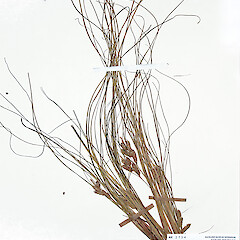Carex pleiostachys
Common name
Fiordland sedge
Synonyms
None
Family
Cyperaceae
Flora category
Vascular – Native
Endemic taxon
Yes
Endemic genus
No
Endemic family
No
Structural class
Sedges
NVS code
The National Vegetation Survey (NVS) Databank is a physical archive and electronic databank containing records of over 94,000 vegetation survey plots - including data from over 19,000 permanent plots. NVS maintains a standard set of species code abbreviations that correspond to standard scientific plant names from the Ngä Tipu o Aotearoa - New Zealand Plants database.
CARPLE
Current conservation status
The conservation status of all known New Zealand vascular plant taxa at the rank of species and below were reassessed in 2017 using the New Zealand Threat Classification System (NZTCS) – more information about this can be found on the NZTCS website. This report includes a statistical summary and brief notes on changes since 2012 and replaces all previous NZTCS lists for vascular plants.
Please note, threat classifications are often suggested by authors when publications fall between NZTCS assessment periods – an interim threat classification status has not been assessed by the NZTCS panel.
- Conservation status of New Zealand indigenous vascular plants, 2017 . 2018. Peter J. de Lange, Jeremy R. Rolfe, John W. Barkla, Shannel P. Courtney, Paul D. Champion, Leon R. Perrie, Sarah M. Beadel, Kerry A. Ford, Ilse Breitwieser, Ines Schönberger, Rowan Hindmarsh-Walls, Peter B. Heenan and Kate Ladley. Department of Conservation. Source: NZTCS and licensed by DOC for reuse under the Creative Commons Attribution 4.0 International licence.
2017 | At Risk – Naturally Uncommon | Qualifiers: RR, Sp
Previous conservation statuses
2012 | At Risk – Naturally Uncommon | Qualifiers: RR, Sp
2009 | At Risk – Naturally Uncommon | Qualifiers: DP
2004 | Range Restricted
Distribution
Endemic. South Island, Fiordland coastline only.
Habitat
Coastal. Said to be a conspicuous species of seal haul outs, and both seal and penguin (rock hopper) colonies. It is known to grow within peaty soil under low shrubs, and on open cobble, and sand beaches. It also colonies cliff faces. It extends well inland up the fiords and has been collected from shingle at various river mouths.
Detailed description
Pale green, densely tufted and leafy sedge of coastal slopes, boulder and cobble beaches and cliff faces. Culms 100–300 × 0.5–1 mm, terete, glabrous; basal sheaths light brown to reddish brown. Leaves distinctly > culms in length, 1–1.5 mm wide, usually concave on the upper surface, often with a obvious median groove, and convex on the underside, margins scabrid with the apices much curled; sheaths rather long, extending for up to ½ the length of the lamina. Inflorescence composed of 5–7 spikes, these 10–20 × 4–7 mm. The terminal spike male; remaining spikes female, with occasional male spikes near the base. Spikes: uppermost more or less approximate, sessile; lower spikes shortly pedunculate, the lowermost typically set well back and more distant from the others; leaf-like bracts subtending spikes long with distinctly curled apices. Glumes (excluding awn) almost equal to or just shorter than utricles, ovate, acute or emarginated, membranous, cream with light brown striae, midrib paler, prolonged as a scabrid awn of varying length. Utricles 3–4 × 1 mm, subtrigonous, narrow-lanceolate, green to greenish-brown with white to pale brown nerves, this fading at maturity, margins glabrous; beak tapering gradually, 1–1.5 mm long, crura bifid, glabrous; stipe 0.5 mm long. Stigmas 3. Nut 2 mm long, dark brown, oblong-obovoid, trigonous.
Similar taxa
Somewhat similar to C. comans Bergg. with which it shares narrow, concavo-convex leaves and short, light coloured spikes. Nevertheless, C. pleiostachys differs from C. comans by its broader spikelets, and glabrous rather than scabrid-beaked utricles. Carex pleiostachys is also superficially similar to C. fretalis Hamlin from which it differs by its approximate rather than evenly spaced spikes, and presence of a distinctive utricle beak (virtually absent in C. fretalis). In C. fretalis the crura is distinctly scabrid while in C. pleiostachys it is entirely glabrous.
Flowering
Unknown
Fruiting
Unknown
Life cycle
Nuts surrounded by inflated utricles are dispersed by granivory and wind (Thorsen et al., 2009).
Propagation technique
As far as is known this species has yet to be cultivated. It would probably be easily grown and tolerant of most conditions provided it was planted in a moist soil.
Threats
Because of the remote and hazardous nature of the Fiordland coastline this species is not very well known. Preliminary surveys and past field reports suggest that it is locally abundant along some parts of the coastline. For this reason it is currently viewed as a localised, range restricted species. Further survey to clarify status is desired.
Etymology
carex: Latin name for a species of sedge, now applied to the whole group.
Where To Buy
Not commericially available.
Attribution
Description adapted from Moore and Edgar (1970)
References and further reading
Moore LB, Edgar E. 1970. Flora of New Zealand, Volume II. Indigenous Tracheophyta: Monocotyledones except Gramineae. Government Printer, Wellington, NZ. 354 p.
Thorsen MJ, Dickinson KJM, Seddon PJ. 2009. Seed dispersal systems in the New Zealand flora. Perspectives in Plant Ecology, Evolution and Systematics 11: 285–309.


